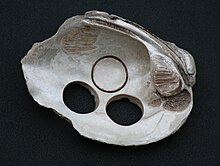Unionidae
| Règne | Animalia |
|---|---|
| Embranchement | Mollusca |
| Classe | Bivalvia |
| Sous-classe | Palaeoheterodonta |
| Ordre | Unionoida |
Les Unionidae sont une famille de mollusques bivalves d'eau douce appartenant à l'ordre monophylétique des Unionoida[1],[2],[3].










Les espèces de cette famille sont appelées communément moules de rivière ou moules d'eau douce ou mulettes. Certaines espèces peuvent atteindre une grande taille (jusqu'à 20 cm) et un grand âge (plus d'un siècle) avec localement (ou autrefois) des populations très denses,
- World Register of Marine Species (3 février 2009)
- Bieler R., Carter J.G. & Coan E.V. (2010). Classification of Bivalve families. p. 113–133, in: Bouchet P. & Rocroi J.-P. (2010), Nomenclator of Bivalve Families. Malacologia 52(2): 1–184.
- (en) Huber, Markus, Compendium of Bivalves. A Full-color Guide to 3'300 of the World's Marine Bivalves. A Status on Bivalvia after 250 Years of Research, Hackenheim, ConchBooks, , 901 pp. + CD (ISBN 978-3-939767-28-2)
- Coker, R.E. 1919. Fresh-water mussels and mussel industries of the U.S. Bulletin of the Bureau of Fisheries [Issued separately as U.S. Bureau of Fisheries Document 865]. 36(1917–18): 13–89 + 46 plates.
- Cochran, T. G. II, and J. B. Layzer. 1993. Effects of commercial harvest on unionid habitat use in the Green and Barren rivers, Kentucky. In Conservation and Management of Freshwater Mussels. K. S. Cummings, A. C. Buchanan, and L. M. Koch (eds.). Proceedings of a UMRCC symposium, 12–14 October 1992, St. Louis, MO, Upper Mississippi River Conservation Committee, Rock Island, IL, p. 61-65.
- See: MUSSELS: Washboards, Buttons and Pearls, at
